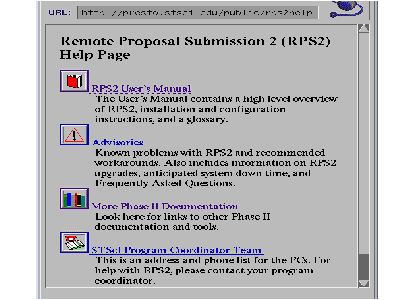

The RPS2 system can help you write and submit a feasible Phase II observing program that will schedule on HST and make efficient use of your allotted telescope time.
Anyone with internet access can use RPS2 in some form. Currently, RPS2 is configured to run only in unix environments (see Possible Configurations). However, it can be run remotely and displayed back to a graphical device that supports XWindows (e.g., VAX Workstations, Macs). For anyone who does not have access to a graphical workstation, see How to Run the Command Line Version of RPS2.
If you encounter any problems while installing or running RPS2, please contact your Program Coordinator (PC) . The PCs maintain a list of advisories describing known problems and recommended workarounds. This list is available on the STScI Web page for Phase II Proposal Development, http://www.stsci.edu/public/rps2home.html.
You also can get this list by clicking on " Help " on the RPS2 User Interface (see Bringing up the RPS2 Graphical Interface).

The look and feel of version 8 is basically the same as version 7. Here is a summary of the changes and improvements:
RPS2 can help you use your orbit allocation as efficiently as possible. One way you can do this is through the graphical timeline located in the structure section of the Visit Analysis Report (see The Visit Analysis Report). Although this is a good model of what will happen during your observations, it is not an exact timeline of the observing events. If you need help optimizing your proposal, talk with your PC.
Some of the graphical timeline limitations are due to conceptual simplifications built into RPS2. One important example is "alignment" overhead. Alignments are generally groups of exposures that use the same aperture and pointing, but the detailed rules are much more complex. As a simplification, RPS2 does not display the alignment structure, so it cannot show you where the alignment overheads actually occur. In RPS2 all alignment overhead is distributed evenly among the exposures within the alignment.
Since HST is in low earth orbit, the target viewing time varies over the course of the year. Unless you specify timing special requirements, you will not be guaranteed the precise structure given in the Visit Analysis Report. Generally, this is not a problem, but it can be if timing is critical.
If exposures must be done back-to-back, you should use the SEQuence NON-INTerruptible Special Requirement. Using timing special requirements can increase overhead and decrease the scheduling flexibility of your visit, so you should use them only if scientifically justified. (See the Phase II Proposal Instructions for information regarding timing special requirements.)
While RPS2 has, at its heart, the same software that is used at STScI to evaluate and prepare a proposal, not all of the STScI processing capabilities are available. Therefore, there are some situations in which RPS2 will display a visit as schedulable at a particular time when it is actually not schedulable, and other situations where the converse is true.
For example, the current version of RPS2 does not have the capability to test for guide star availability. Therefore, a visit which appears to be schedulable in RPS2 may in fact not be schedulable due to lack of appropriate guide stars for the target. This can be determined only after your Phase II proposal has been submitted and processed at STScI.
| Abstract and Table of Contents | Previous Section | Next Section |